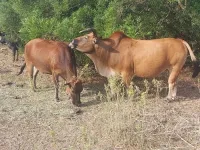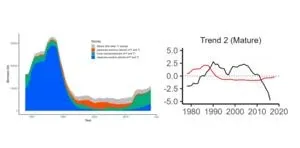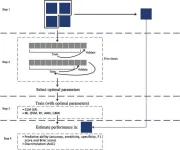(Press-News.org) HONG KONG (28 Feb 2024) — Unique insights into the social lives of cattle revealed in a new study by scientists at City University of Hong Kong (CityUHK) can enhance our understanding of animal behaviour and welfare. The study suggests that sex and social status influence social grooming (where one animal licks another, also known as allogrooming) among free-ranging feral cattle in Hong Kong.
The CityUHK researchers found that feral cattle performed preferential grooming of certain individuals and, in particular, that more dominant females received more grooming. This asymmetrical distribution of licking also applied to whom male cattle decided to lick, according to the study published in Animal Behaviour.
While over a billion cattle are used in production globally, free-ranging feral cattle are relatively unique in Hong Kong, with approximately 900 brown cattle across the region.
“Most research on cattle behaviours is conducted on farms, and so the opportunity to study cattle behaviour in free-ranging groups is rare, as there are only a few feral populations worldwide,” says Alan McElligott of CityUHK’s Department of Infectious Diseases and Public Health in the Jockey Club College of Veterinary Medicine and Life Sciences (JCC).
McElligott co-led the study with PhD researcher George M. W. Hodgson of the Department of Infectious Diseases and Public Health. Other team members include Professor Kate J. Flay and Tania A. Perroux of CityUHK’s Department of Veterinary Clinical Sciences, and Dr Wai Yan Chan, a graduate of JCC’s Bachelor of Veterinary Medicine programme.
Studying feral cattle social behaviours will aid our understanding of how and why these kinds of friendly behaviours have evolved, adds McElligott, also a member of CityUHK’s Centre for Animal Health and Welfare.
The research team conducted observations from February to May 2022 on a mixed-sex cattle herd in Sai Kung East Country Park in Hong Kong and collected data from 47 to 56 cattle per observation day.
The CityUHK team found that all individuals received allogrooming but that not all individuals performed allogrooming. Males performed allogrooming more towards females than other males, but females groomed both sexes equally, suggesting a sex-specific aspect to cattle behaviour that is not usually evident when studying them on farms.
Although higher-ranking females (i.e., more dominant animals) received more allogrooming from other individuals than subordinates, no such pattern was found for males. The team also found that high-ranking animals exchanged more friendly grooming between themselves, suggesting that high-ranking females are more attractive as social partners.
“This suggests that grooming isn’t directed to higher-ranking animals for exchanging rank-related benefits such as food or protection, as has been found in primates, but rather is used to strengthen social bonds and promote affiliation within the group,” said Hodgson.
The team also found that the neck and head were the most commonly groomed regions for the cattle, whereas fewer allogrooming events were performed on the legs and belly.
“Social behaviours such as grooming or dominance are crucial in developing and maintaining herd relationships for farmed and feral cattle,” said Professor Flay. "These preferential interactions are important to understand, as they can affect cattle and other ruminants’ health, such as parasite burdens and infectious disease transmission.”
The takeaway from the study is that these preferential allogrooming patterns improve our knowledge of sex-specific interactions and help us to understand the dynamics of agonistic and affiliative behaviours in multi-male, multi-female, ungulate groups.
“These results are essential for understanding patterns of positive social relationships and what good welfare means for cattle, especially when they are free to choose with whom to interact,” said Professor McElligott.
Photos: https://drive.google.com/drive/folders/1JEf8N4TQ3xz1nKGUCed4SQJgvjXTKEvh
/ends
END
A liking for licking
—sex and social status influence social grooming among free-ranging feral cattle in Hong Kong
2024-02-28
ELSE PRESS RELEASES FROM THIS DATE:
Scientists provide first detailed estimates of how much sediment is supplied to coral islands from the reef system
2024-02-28
Scientists have produced the first detailed estimates of how much sediment is transported onto the shores of coral reef islands, and how that might enable them to withstand the future threats posed by climate change.
Coral reef islands are low-lying accumulations of sand and gravel-sized sediment deposited on coral reef surfaces.
The sediments are derived from the broken down remains of corals and other organisms that grow on the surrounding reef. Therefore, the rate of supply of sediment from reefs is a critical control on island formation and future change.
The international team of researchers used data available for 28 reef islands in the Indian and Pacific Oceans, widely ...
Study details five cutting-edge advances in biomedical engineering and their applications in medicine
2024-02-28
Bridging precision engineering and precision medicine to create personalized physiology avatars. Pursuing on-demand tissue and organ engineering for human health. Revolutionizing neuroscience by using AI to engineer advanced brain interface systems. Engineering the immune system for health and wellness. Designing and engineering genomes for organism repurposing and genomic perturbations.
These are the five research areas where the field of biomedical engineering has the potential to achieve tremendous impact on the field of medicine, according to “Grand Challenges at the Interface of Engineering and Medicine,” a study published by a 50-person task force published ...
Traditional regression approach outperformed machine learning algorithms in predicting optimal surgical method in patients with submucosal tumors.
2024-02-28
Submucosal tumors (SMTs) are usually found in the stomach and esophagus during an upper endoscopy. Submucosal tunneling endoscopic resection (STER) and non-tunneling endoscopic resection (NTER) are the two most commonly used techniques in the treatment of gastric and esophageal SMTs. As novel technologies continue to shape the medical landscape, machine learning (ML) algorithms find increased application, demonstrating enhanced performance in various fields. Although some studies have evaluated the incremental value of flexible ML methods, comparisons with traditional logistic regression (LR) models are lacking.
To this end, a recent study by a team of researchers from China published in the ...
A survey on federated learning: A perspective from multi-party computation
2024-02-28
Federated learning (FL) has emerged as a popular machine learning paradigm which allows multiple data owners to train models collaboratively with out sharing their raw datasets. It holds potential for a wide spectrum of nalytics applications on sensitive data. For example, federated learning has been applied on medical big data analysis such as disease prediction and diagnosis without revealing the patients’ private medical information to thirdparty services. It has also been exploited by banks and insurance ...
New pediatric cancer marker, new hope for a treatment target
2024-02-28
Researchers have newly identified a universal, essential biomarker for the childhood cancer neuroblastoma – and a potential new target for treatment.
Neuroblastoma accounts for 15% of all pediatric cancer deaths and is the most common source of childhood tumors outside of brain cancer. The disease develops in early nerve tissue, usually in and around the adrenal glands, and typically affects children under age five. High-risk cases have a five-year survival rate of just 50%.
Led by UC San Francisco, researchers suspected the oncoprotein AF1q, which is known to play a role in leukemia and solid tumor progression, might be important in tumors of neural origin ...
Could we assess autism in children with a simple eye reflex test?
2024-02-28
Scientists at UC San Francisco may have discovered a new way to test for autism by measuring how children’s eyes move when they turn their heads.
They found that kids who carry a variant of a gene that is associated with severe autism are hypersensitive to this motion.
The gene, SCN2A, makes an ion channel that is found throughout the brain, including the region that coordinates movement, called the cerebellum. Ion channels allow electrical charges in and out of cells and are fundamental to how they function. Several variants ...
Researchers closer to understanding hydrogen's great challenge
2024-02-28
Why hydrogen causes steels to become brittle and crack is the great conundrum of engineers and researchers looking to develop large-scale transport and storage solutions for the hydrogen age – an era which Australia hopes to lead by 2030.
They may now be one step closer to understanding how hydrogen affects steels, thanks to new University of Sydney research. The researchers found adding the chemical element molybdenum to steel reinforced with metal carbides markedly enhances its ability to ...
Concerted efforts urgently needed to meet 2030 Global Alcohol Action Plan targets
2024-02-28
Concerted international efforts are urgently needed to meet the targets set out in the 2030 Global Alcohol Action Plan (GAAP) and avert “dire consequences” for low and middle income countries, where alcohol markets are expanding, warn health scientists in the open access journal BMJ Global Health.
A lack of progress on alcohol and health in the wake of the 2010 Global Strategy for Reducing the Harmful Use of Alcohol prompted the 75th World Health Assembly to initiate the Global Alcohol Action Plan 2022-30 and declare alcohol a public health priority, ...
Sinusitis linked to 40% heightened risk of rheumatic disease
2024-02-28
The common inflammatory condition sinusitis is linked to a 40% heightened risk of a subsequent diagnosis of rheumatic disease, particularly in the 5 to 10 years preceding the start of symptoms, finds research published in the open access journal RMD Open.
The risks seem to be greatest for a blood clotting disorder (antiphospholipid syndrome) and a condition that affects the body’s production of fluids, such as spit and tears, known as Sjögren’s syndrome, the findings indicate.
Sinusitis refers to inflammation of the lining of ...
Poorly controlled asthma emits same quantity of greenhouse gas as 124,000 homes each year in the UK
2024-02-28
Patients whose asthma is poorly controlled have eight times excess greenhouse gas emissions compared with those whose condition is well controlled—equivalent to that produced by 124,000 homes each year in the UK—indicates the first study of its kind, published online in the journal Thorax.
Improving the care of asthma patients could achieve substantial carbon emissions savings, and help the NHS meet its net zero target, say the researchers.
Healthcare is a major contributor to greenhouse gas emissions and in 2020 the NHS set an ambitious target of reducing its carbon footprint by 80% over the next 15 years, with the aim of reaching net zero by 2045, ...
LAST 30 PRESS RELEASES:
Orthopedics can play critical role in identifying intimate partner violence
Worms as particle sweepers
Second spider-parasitic mite described in Brazil
January 2026 issues of APA journals feature new research on autism, pediatric anxiety, psychedelic therapy, suicide prevention and more
Private equity acquired more than 500 autism centers over the past decade, new study shows
New cervical cancer screening guidelines from the US Department of Health and Human Services
Estimated burden of COVID-19 illnesses, medical visits, hospitalizations, and deaths in the US from October 2022 to September 2024
Smartphone use during school hours by US youth
Food insecurity and adverse social conditions tied to increased risk of long COVID in children
Earliest, hottest galaxy cluster gas on record could change our cosmological models
Greenland’s Prudhoe Dome ice cap was completely gone only 7,000 years ago, first GreenDrill study finds
Scientific validity of blue zones longevity research confirmed
Injectable breast ‘implant’ offers alternative to traditional surgeries
Neuroscientists devise formulas to measure multilingualism
New prostate cancer trial seeks to reduce toxicity without sacrificing efficacy
Geometry shapes life
A CRISPR screen reveals many previously unrecognized genes required for brain development and a new neurodevelopmental disorder
Hot flush treatment has anti-breast cancer activity, study finds
Securing AI systems against growing cybersecurity threats
Longest observation of an active solar region
Why nail-biting, procrastination and other self-sabotaging behaviors are rooted in survival instincts
Regional variations in mechanical properties of porcine leptomeninges
Artificial empathy in therapy and healthcare: advancements in interpersonal interaction technologies
Why some brains switch gears more efficiently than others
UVA’s Jundong Li wins ICDM’S 2025 Tao Li Award for data mining, machine learning
UVA’s low-power, high-performance computer power player Mircea Stan earns National Academy of Inventors fellowship
Not playing by the rules: USU researcher explores filamentous algae dynamics in rivers
Do our body clocks influence our risk of dementia?
Anthropologists offer new evidence of bipedalism in long-debated fossil discovery
Safer receipt paper from wood
[Press-News.org] A liking for licking—sex and social status influence social grooming among free-ranging feral cattle in Hong Kong





